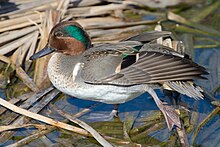Green-winged teal
| Green-winged teal | |
|---|---|
 |
|
| Male | |
 |
|
| A pair, male in nuptial plumage at rear | |
| Scientific classification | |
| Kingdom: | Animalia |
| Phylum: | Chordata |
| Class: | Aves |
| Order: | Anseriformes |
| Family: | Anatidae |
| Subfamily: | Anatinae |
| Genus: | Anas |
| Species: | A. carolinensis, see text |
| Binomial name | |
|
Anas carolinensis Gmelin, 1789 |
|
 |
|
| Nesting range Year-round range Wintering range | |
| Synonyms | |
|
Anas crecca carolinensis |
|
Anas crecca carolinensis
Nettion carolinensis
The green-winged teal (Anas carolinensis or Anas crecca carolinensis) is a common and widespread duck that breeds in the northern areas of North America except on the Aleutian Islands. It was considered conspecific with the common teal (A. crecca) for some time but the issue is still being reviewed by the American Ornithologists' Union; based on this the IUCN and BirdLife International do not accept it as a separate species at present. However, nearly all other authorities consider it distinct based on behavioral, morphological, and molecular evidence. The scientific name is from Latin Anas, "duck" and carolinensis, "of Carolina".
This dabbling duck is strongly migratory and winters far south of its breeding range. It is highly gregarious outside of the breeding season and will form large flocks. In flight, the fast, twisting flocks resemble waders.
This is the smallest North American dabbling duck. The breeding male has grey flanks and back, with a yellow rear end and a white-edged green speculum, obvious in flight or at rest. It has a chestnut head with a green eye patch. It is distinguished from drake common teals (the Eurasian relative of this bird) by a vertical white stripe on side of breast, the lack of both a horizontal white scapular stripe and the lack of thin buff lines on its head.
The females are light brown, with plumage much like a female mallard. They can be distinguished from most ducks on size, shape, and the speculum. Separation from female common teal is problematic.
In non-breeding (eclipse) plumage, the drake looks more like the female.
...
Wikipedia
